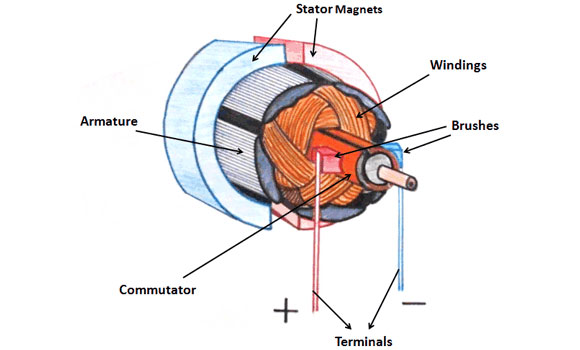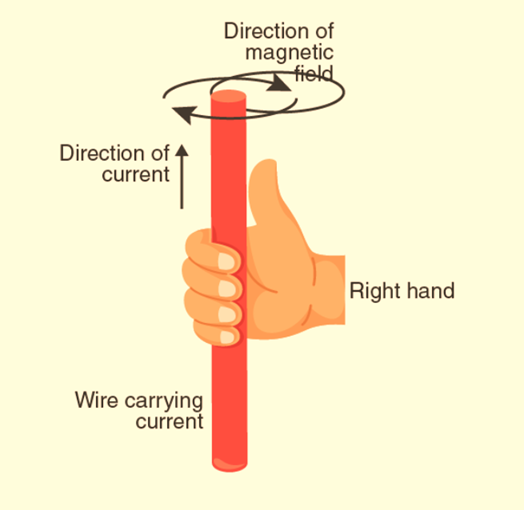Magnetic Field
Subject: Science

Overview
Hans Christian Oersted discovered the connection between electricity and magnetism in 1820 after observing the magnetic compass needle deflecting in an electric circuit. The magnetic effect of current creates a magnetic field around a conducting wire when an electric current flows through it. The direction of the current flow determines the direction of the magnetic field. Maxwell's right-hand-thumb rule can be used to determine the direction of the magnetic field around a current-carrying wire. A solenoid is a cylindrical coil made of insulated wire, and its magnetic flux is the total number of magnetic lines of force that flow through the surface area within the magnetic field. The motor effect is the motion produced in a wire when current is delivered through it and put into a magnetic field. The motor effect is what drives devices like mixer grinders, fans, and water pumps.
Magnetic Effect of Electric Current
Hans Christian Oersted, a Danish scientist and science teacher, established the connection between electricity and magnetism in 1820. While conducting an electric current experiment, he noticed that the magnetic compass needle deflected in the vicinity of an electric circuit. Subsequent investigation revealed that the direction of the magnetic needle's deflection varies in tandem with the circuit's current flow direction. Orested came to the conclusion that the magnetic effect the electric current produces is what causes the compass needle to deviate.
The magnetic effect of current is the creation of a magnetic field surrounding a conducting wire when there is an electric current flowing through it. The direction of the electric current flowing through the wire determines the direction of the magnetic field that is therefore created.
Magnetic Field Around a Current-carrying Straight Wire
By drawing lines of magnetic force as indicated in the figure, one may view the magnetic field that is created around a straight wire as a result of the electric current flowing through it.
The needles of magnetic compasses point in a specific direction and show a circular pattern when they are wrapped around the wire, as in the exercise above, as seen in Figure. When there is current flowing through a wire, a magnetic field that forms in a circle around the wire is what causes this phenomenon. The direction in which the electric current flows through the wire determines the direction of the magnetic field that is therefore created. The magnetic field is oriented counterclockwise if the electric current is flowing upward via the wire, as seen in Figure. In contrast, the magnetic field is directed in a clockwise direction if the current exits the wire below. By monitoring the direction of the compass needle's pointer, one may also determine the direction of the magnetic field in the activity mentioned above.
Maxwell's right-hand-thumb rule states that the fingers encircling a current-carrying wire, when held with the right hand in such a way that the thumb points in the direction of the current flow (as illustrated in Figure), point in the direction of the magnetic field.
Magnetic Field Around a Solenoid
A solenoid is a cylindrical coil made of insulated wire, as shown in the figure. In most cases, making a solenoid involves wrapping insulated wire around a cylindrical object. When the insulation of the two ends of the wire used to make the solenoid is removed and connected to a battery, current flows through the wire and a magnetic field develops in and around the solenoid. The magnetic field outside the solenoid is similar to the magnetic field around the bar magnet, i.e., the magnetic field of a solenoid is strong on both sides and weak in the middle portion. There is a uniform magnetic field inside the solenoid. Generally, when electric current flows in the solenoid, one end of it becomes the North Pole and the other the South Pole. If the electric current flows in the opposite direction, the poles of the magnetic field formed around it are also reversed.

Maxwell's right-hand grip rule may be used to determine the direction of the magnetic field that has developed around the current-flowing solenoid. This rule states that the thumb points to the north pole of the magnetic field deloped in the solenoid when a solenoid is held in the right hand in such a way that the fingers indicate the direction of the current through the solenoid. These variables determine how strong the magnetic field is surrounding a solenoid.
- Solenoid's current magnitude
- Number of turns in the solenoid's coil
- A substance inserted into the solenoid's core.A soft iron cylinder, for example, is a material that strengthens the magnetic field.
The solenoid is used to produce a transient magnetic field, which is why an electromagnet is made with it.
Magnetic Flux
The magnetic flux is the total number of magnetic lines of force that flow through the surface area within the magnetic field. The magnetic field flowing across a surface area in a magnetic field is measured as magnetic flux. In Greek, the symbol for magnetic flux is phi. Wb stands for Weber, the magnetic flux unit. The unit has the surname of Wilhelm Eduard Weber, a scientist from Germany.
The density of magnetic lines of force serves as a proxy for the magnetic flux's magnitude. Stronger magnetic fluxes are found in regions with denser magnetic lines of force, while weaker magnetic fluxes are found in areas with lower density. We may determine that the magnetic flux is stronger in the poles than it is in the middle by looking at the density of the magnetic lines of force of the bar magnet in the figure.
Motor Effect

The motor effect is the motion that is produced in a wire when current is delivered through it and it is put in a magnetic field. The motor effect is what drives devices like mixer grinders, fans, water pumps, and more. The figure depicts the direction of a bar magnet's magnetic field as well as the circular magnetic field that forms around a wire when current passes through it. The attraction and repulsion between the two magnetic fields are what cause motion in the wire.
An insulated wire is wound around a core to create the coil of a motor. It is illustrated in the figure that the coil is positioned between two opposing magnetic poles. After that, a.c. is sent via the coil. A magnetic field surrounds the coil as electricity flows through it. The coil's magnetic field constantly shifts direction due to the alternating current. The permanent magnet's magnetic field and the one that is created inside the coil interact to cause the coil to rotate. The other item tied to it then turns as a result.
Increases in coil surface area and number of turns, together with the use of a stronger magnet and a soft iron core, can all be used as ways to speed the rotation of the coil of a motor.
Things to remember
- Hans Christian Oersted, a Danish scientist, established the connection between electricity and magnetism in 1820 when he observed that the magnetic compass needle deflects in the vicinity of an electric circuit due to the magnetic effect of the electric current.
- The magnetic field is oriented counterclockwise if the electric current is flowing upward via the wire and clockwise if the current exits the wire below.
- Maxwell's right-hand grip rule can be used to determine the direction of the magnetic field around a current-flowing solenoid.
- The magnetic flux is the total number of magnetic lines of force that flow through the surface area within the magnetic field.
- The motor effect is the motion produced in a wire when current is delivered through it and put into a magnetic field.
© 2021 Saralmind. All Rights Reserved.



-(1).jpg)
 Login with google
Login with google